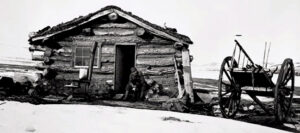Miywasin Moment: Stories beneath the surface
By JoLynn Parenteau on February 8, 2023.

A Metis man sits outside his Hivernant cabin, 1870s, Cypress Hills region.-PHOTO COURTESY ERIC TEBBY, GLENBOW ARCHIVES
“In the beginning, we were there using the land to meet our needs for shelter, food and economy…”
– Audrey Poitras, president of the Metis Nation of Alberta
The South Eastern Alberta Archaeological Society has a deep love for this land.
Celebrating its 50th anniversary in 2023, SEAAS’s relationship with this rugged region of Northern Turtle Island (Native Canada) has stood the test of time. The Society’s secret to its long-lasting zeal for the earth and its inhabitants past and present is respect.
“The South Eastern Alberta Archaeological Society of Alberta acknowledges the connection that many peoples hold to the area where we now live. We are committed to a relationship with Indigenous peoples based on the principles of mutual trust, respect, reciprocity and collaboration in the spirit of reconciliation,” said Society President Bruce Shepard in an opening land acknowledgment.
A curiosity for our shared history keeps members engaged. At its most recent meeting Jan. 25, the society welcomed University of Alberta Masters student and historical archaeologist Eric Tebby via Zoom to present his knowledge and research on Métis Hivernant sites at Wood Mountain and Chimney Coulee in Eastend, Sask.
Presenting virtually to members gathered in Medicine Hat College’s Omahksipiitaa (Blackfoot, ‘Big Eagle’) Room and online, Tebby’s passion for his field of study is remarkable. Though not of Metis heritage himself, a deep knowledge of the history and culture of the Metis people is infused in Tebby’s vocation and presentation.
The Metis Nation has an historical and generational homeland which was mapped along the fur trade routes from modern-day western Ontario to northeastern British Columbia, to the southern Northwest Territories and across northern Minnesota, North Dakota and Montana. Metis ancestry, culture, history and language run deep through these lands.
Long before Saskatchewan and Alberta existed as provinces, the Metis people had arrived here, following the bison’s migration routes and sheltering over winter in wooded prairie sites such as Wood Mountain and the Cypress Hills. A Metis hunter’s lifestyle, and by extension their log cabins, became known as “Hivernant”, the French word for “winterer.” Through extensive family ties, the Metis established themselves in the prairies in the 1800s and settled the west.
Careful archeological exploration by Tebby and his team in 2017 and 2018 at a Chimney Coulee cabin site have unearthed a wealth of everyday artifacts from early Hivernant life. The cabins there were built for wintering through 1871 and burned down the following spring, but the chimney stacks remained, giving the site its moniker.
A grid map of Tebby’s team’s excavation site detailed everyday items found inside and outside the former cabin wall. Patterned kitchen ceramic fragments, buttons, sewing needles and more than 2,000 coloured seed beads paint a picture of Hivernant wives’ evenings spent mending and adorning moccasins by the fireplace and oil lamp light.
Two discoveries in particular stand out as exceptional and significant. First, Tebby spent two days painstakingly revealing a perfectly preserved flower bead pattern left pressed into the earth, most likely once sewn into a hide satchel or moccasin, which had disintegrated over the past 150 years. More than 400 beads in shades of red and green were used to create this pattern; the Metis are known as the “flower beadwork people.”
Tebby’s discovery can be seen on Wild Archaeology’s YouTube episode, Coolest Find at Chimney Coulee.
Secondly, an abundance of fish bones and scales peppered the excavation site. Whitefish from a nearby lake supplemented the Hivernant diet, but the Metis are also known to use dyed whitefish scales in intricate art pieces.
Threads of our ancestors’ lives are just beneath the surface; of the land, in diaries, in kitchen table conversations with elders. These stories are waiting to be rediscovered and retold to a new generation. The SEAAS’s passion for our past is keeping these stories alive.
The public is invited to attend the South Eastern Alberta Archaeological Society’s annual general meeting Feb. 15, 6 p.m. at Medicine Hat College’s Crowfoot Room. New members are welcome and can look forward to monthly presentations from guest speakers and excursions in spring and fall. Follow on Instagram @medicinehatarchaeology or Facebook @seaarkysociety for updates.
JoLynn Parenteau is a Metis writer out of Miywasin Friendship Centre. Column feedback can be sent to
jolynn.parenteau@gmail.com
18
-17
 A Metis man sits outside his Hivernant cabin, 1870s, Cypress Hills region.-PHOTO COURTESY ERIC TEBBY, GLENBOW ARCHIVES
A Metis man sits outside his Hivernant cabin, 1870s, Cypress Hills region.-PHOTO COURTESY ERIC TEBBY, GLENBOW ARCHIVES A Metis man sits outside his Hivernant cabin, 1870s, Cypress Hills region.-PHOTO COURTESY ERIC TEBBY, GLENBOW ARCHIVES
A Metis man sits outside his Hivernant cabin, 1870s, Cypress Hills region.-PHOTO COURTESY ERIC TEBBY, GLENBOW ARCHIVES